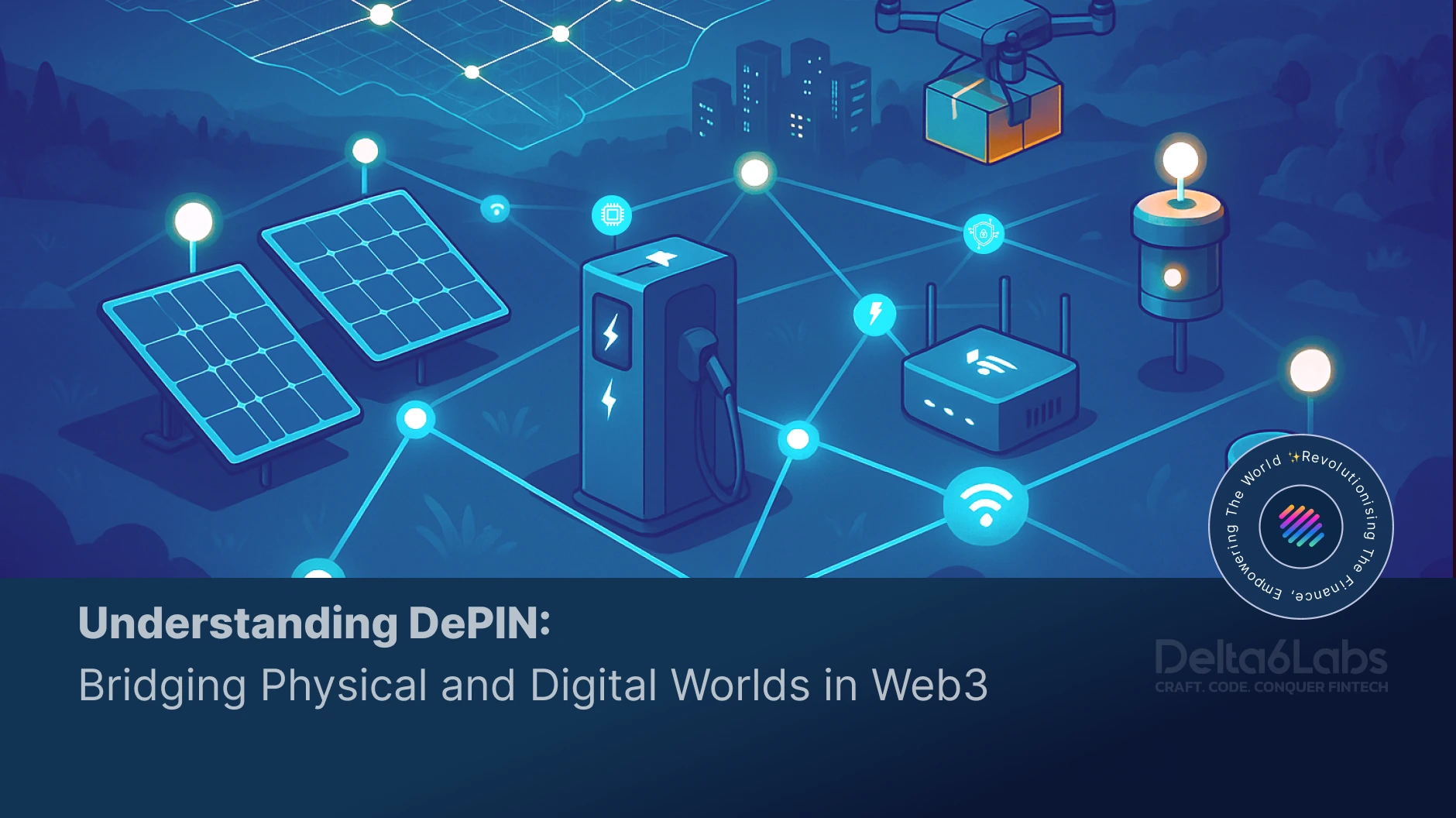Understanding DePIN: Bridging Physical and Digital Worlds in Web3
Table of Contents
DePIN (Decentralized Physical Infrastructure Network) has emerged as the perfect solution to address this problem in the Web3 landscape. With advancements in technology, the physical and digital worlds are coming closer. However, there are a few issues related to transparency, flexibility, and cost in the traditional infrastructure. DePIN tends to address this issue by providing a model that is transparent, flexible, and more cost-effective.
In this blog, we will discuss in detail everything one should know about DePIN.
Understanding DePIN (Decentralized Physical Infrastructure Network)
DePIN is a technology that bridges the gap between physical and digital worlds by leveraging blockchain technology, smart contracts, tokenomics, and physical infrastructure elements. It builds a network for things like Wi-Fi, data storage, and other tangible devices, empowering people to share resources with other users without the need for an intermediary.
Let us throw some light on this example. Imagine a social club where people gather to play video games, read comic books, and enjoy novels. Now, the social club is embedded with a decentralized system and transforms itself into a DePIN-powered platform. Everyone can contribute to the platform by sharing and borrowing games, rewards, books, and novels. Every distribution-related information is stored on the blockchain, making it transparent, open to all, and immutable.
People can utilize the DePIN services by paying for them using cryptocurrencies, such as Bitcoin and Ethereum. Additionally, users who contribute to the DePINs are awarded with tokens.
Key Components of DePIN
There are the following four fundamental components of DePIN:
Blockchain Technology
Blockchain technology is the primary component of the DePIN model; essentially, it serves as the backbone of every DePIN project. It helps build a decentralized, immutable, and transparent system that is open for everyone to contribute to and use. It is vital to choose a blockchain that suits the needs of the project, such as scalability, transaction speed, consensus mechanism, governance model, and interoperability. Layer 2 solutions are integrated to enhance scalability, speed, and reduce costs.
Smart Contracts
Smart contracts are the basic building blocks of every decentralized network. They can execute themselves automatically when the predetermined conditions are met. They play a pivotal role in providing security and enhancing transparency in DePIN by automating the processes. Smart contracts can also operate across multiple blockchains, strengthening the network’s utility and reach.
Tokenomics
Tokenomics represents the creation, allocation, and management of a cryptocurrency. It is the integral factor that helps determine the utility of a crypto token within a network. It also helps manage the supply and demand of a token in the crypto market. In DePINs, tokenomics helps token holders understand their role in the project’s governance. Tokenomics helps determine how tokens will be distributed to users who contribute to the DePIN.
Physical Infrastructure Elements
All the tangible elements that support decentralized technology to create a DePIN project are referred to as physical infrastructure elements. They are the existing elements that, when merged with blockchain technology, become a perfect combination of physical and digital worlds. Mining equipment, data centers, and network nodes are physical elements that provide the required server, hardware, and internet support.
Types of DePIN
Sensor Networks
Sensors are used to collect and transmit data in a specific environment, helping to monitor and control the project by providing valuable insights that are valuable in decision-making. They can be easily deployed at multiple locations and retrieve critical information, such as temperature, humidity, and motion. There are three types of sensor networks: Wireless Sensor Networks, Body Sensor Networks, and Environmental Sensor Networks.
Energy Grids
DePIN projects facilitate the decentralized distribution, consumption, and production of energy, thereby creating a robust, decentralized, and resilient energy distribution system. It also enables users to trade excess energy with others without any operational barriers, through a peer-to-peer energy trading mechanism. Smart contracts are a key component of a DePIN project, facilitating transparent and automated energy trading. LO3 Energy is one of the promising energy grids and DePIN projects.
Storage Solutions
DePIN projects empower businesses by providing a new method to store data. In DePIN projects, it is not necessary to rely on a single, central system, as the data is distributed across various nodes. There are multiple types of storage solutions, including local storage, network-attached storage, cloud storage, and portable self-storage.
Wireless Network
DePIN is focused on building a decentralized communication system that is more resilient, efficient, and accessible. Local communities can establish their networks with the help of wireless DePINs and provide internet access in remote areas. Helium and Althea are two famous wireless DePINs. Distribution of connectivity across various nodes helps save the project from a single point of failure.
Benefits of Decentralized Physical Infrastructure Network (DePIN)
True Decentralization
DePIN projects foster decentralization, empower local communities, improve resilience, innovation, and make projects cost-effective. Local distributors and communities can benefit significantly from DePIN projects because they can control the infrastructure and make informed decisions to have a greater impact.
Security
DePIN projects are powered by blockchains, which are a distributed ledger, which means the data is distributed among various nodes, making it difficult for scammers to breach the data. Additionally, users are the sole owners of their data, which implies they have the right to share the information they wish to share and with whom they choose.
Community Ownership
Tokens are rewarded as incentives to users who are contributing to the network in any way. These token holders have governance rights within a DePIN ecosystem. They can vote and make decisions related to the project’s functioning. Additionally, the community members are the true shareholders in the DePIN project’s growth.
Flexibility and Innovation
New services can be easily integrated into DePIN projects, helping start-ups and local organizations to grow and build with flexibility. Through an innovative approach, the community of users makes data-driven decisions, which provides a competitive edge to DePIN projects in the market.
Reduced Costs
Operational costs are relatively lower in the DePIN projects because tasks related to manual labor and physical infrastructure development are streamlined and automated through third parties, utilizing a decentralized network. Resources are allocated automatically through automation and optimization, making the distribution decentralized and transparent, reducing wastage of resources. Henceforth, reducing overall costs.
The Future of DePINs
DePINs are here to stay in the decentralized world for a long time. The global market size of DePIN’s market is expected to reach $3.5 trillion by 2028, according to a report by the World Economic Forum (WEF). Currently, there are approximately 1,500 active DePIN projects worldwide, with a market size ranging between $30 billion and $50 billion. Additionally, the Collaboration of AI with DePIN projects is proving to be a boon for community-driven digital economies and is poised to take DePIN projects to new heights.
Conclusion
Decentralized Physical Infrastructure Networks (DePIN) represent a significant advancement in bridging the gap between physical and digital realms within the Web3 landscape. They leverage blockchain technology, smart contracts, tokenomics, and physical infrastructure to create decentralized systems that enhance transparency, flexibility, and cost-effectiveness.
DePIN enables users to share resources directly, eliminating the need for intermediaries, as exemplified by a social club where members exchange games and books, with all transactions transparently recorded on the blockchain. Key components of DePIN include blockchain technology, which provides an immutable and transparent foundation; smart contracts, which automate processes and enhance security; tokenomics, which governs the utility, distribution, and management of tokens within the network; and physical infrastructure elements, such as mining equipment and data centres that support decentralized operations. Various DePIN projects can be developed, including sensor networks that monitor environmental conditions and decentralized energy grids that facilitate peer-to-peer energy trading.
Overall, DePIN offers innovative solutions to enhance the security and efficiency of various processes, making it a vital component for future developments in decentralized technology and infrastructure.
Frequently Asked Questions
Disclaimer:
The information on this blog is for knowledge purposes only. The content provided is subject to updates, completion, verification, and amendments, which may result in significant changes.
Nothing in this blog is intended to serve as legal, tax, securities, or investment advice of any investment or a solicitation for any product or service.




